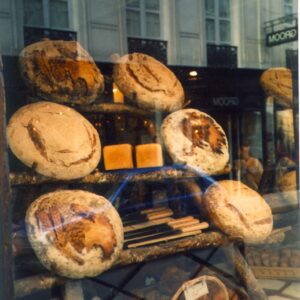
Miche
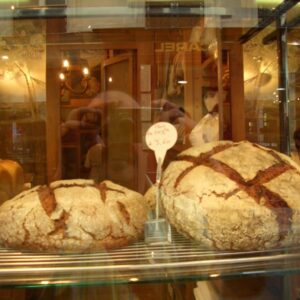
Display Rue de Midi
Returning for the first time to Paris since moving to America as a child (and not having yet become so big on bread) luck brought me walking past Poilânes bakery on 8 rue cherche midi. Giving credit where it’s due, fate gave me my wife, who is not just lovely but also loves a good boutique. She brought me to the neighborhood. Thus I was able to visit the most fabled bakery in all of France, a center of that famous bread the miche.
At the time, being a recent graduate from FCI’s bread course, I was sure I knew something about this great French creation, at least I thought I did. It just so happened a classmate had brought back one of these cherished loaves from her own trip to France. What I remember was that her miche seemed (dare I say it?) a bit traveled! Well traveled! But biting into it, unimpressed, I decided not to dismiss generations of good bread from this fabled boulangerie. And so spotting the Poilânes outside where my wife was visiting the boutique, and then gawking at one of the two kilo miches beckoning from the bakery windows, in truth entranced, I entered the hallowed shop.
I was in heaven. Oh, the glory of that visit. They even let me step down the narrow steps to enter the baking epicenter in the basement, but ” pardon,no photo’s Monsieur!” Overwhelmed, amazed, delighted (all three!) by their well guarded secrets, I considered taking a floor scraping, or even seeing if there was some levain to nab on my way out. Alas no such luck!
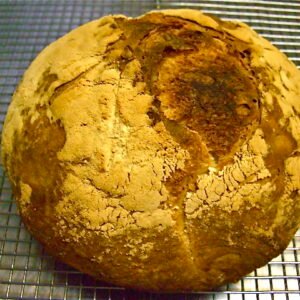
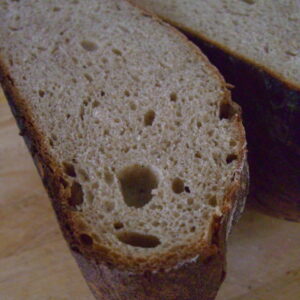
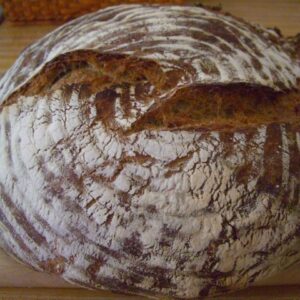
Facon Pôilane miche
Back at home I started to ponder the many miche I had seen and wanted to replicate. Since that first visit, I have done so with some regular success, as well a few dense rocks about which it’s best to forget. One of the best miche on my quest for this icons of French country bread was from none other than my friend Mick Hartley of Bethesdabakers fame.
Bethesdabakers Poilâne 2k Miche
(Micks’s photo of his huge Miche!)

Mick in his yard
(Mick’s adaption from an avid home baker Alan Zelt of his own version of Poilâne‘s miche.)
1st Refreshment In the morning
Take starter from fridge.
Starter 26g
Water 60g
Rye flour 70g
Mix, cover, stand at room temperature.
2nd Refreshment at bedtime
Starter 114g
Water 40g
Plain Flour 128g
Mix and knead to form a ball, cover, stand at room temperature.
The Dough the following morning
Starter 282g
Water 684g
Plain Flour 786g
Spelt Flour 170g
Rye Flour 64g
Salt 28g
Break up the starter and whisk it into the water. Add the remaining ingredients and mix for 8 minutes in the machine. Form into a loose ball and allow to stand for 15 minutes. Form into a boule and place in a ten or eleven inch banneton. (These days I would probably have a four hour bulk fermentation stage at this point with hourly stretching and folding.)
Depending on your starter and the temperature, rising should take between 6-10 hours.
Preheat the oven to Gas 9 (475F, 240C) at hotter if you can. Turn out the dough, slash and bake spraying the oven a few times in the first 15 minutes. You may want to turn down the oven but, in my oven, even though the crust looks as though it is scorching, 50 minutes baking at full ahead gives a comparatively thin crust and a moist crumb. This is a big loaf.
Improves with standing a few hours or overnight.
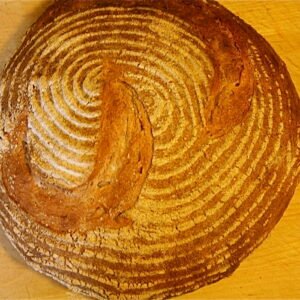
Miche levain
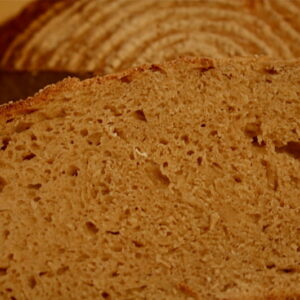
Miche
Just this last week I was making a version of Dan Leader’s favorite levain bread. Again, it is a typical miche. Just by it size alone, it’s huge. While browsing around different bread sites looking at variable in flour, percentages, etc…I fed a mixed levain of rye and wheat I had stored in my fridge from my last version of Amy Scherbers miche, made it up like a stiff levain from Dam Leaders Bread Alone book. From a recent visitor on this site, Jude, I patterned his flour mix from Peter Reinharts Poilâne miche using the same amount of water, 75% white whole wheat flour and 25% Bread flour to see if it would mimic the high extraction flour commonly used in this sort of bread. As usual my schedule was pretty much all over the place, so between shifts I fed the starter, retarded it overnight, then made the dough in the early morning with about a 3 hour rise. Then retarded the dough till the the afternoon, when I shaped it and put it back in the fridge for another 18 hours till the next morning whereI let it sit out for a couple of hours to come to temperature and in the oven. Success, the loaf was well expanded and I cut into it and the crumb was somewhat tight but the loaf it self was moist and was not as sour as I expected it to be, actually it was rather balanced.
Miche (adapted from Bouley Bakery)
222g whole wheat flour
1024g t65 flour
33g Rye
891g water
28.salt
2200
168g t65 flour
168g water
168g starter
505
222g Whole wheat flour
855g t65 flour
33g Rye
722g water
28g salt
337g levain
2200
During this search I happened on a newsgroup that included Mike Avery, as well our friend Vincent Talleu who actually went for a trial stage at Poilâne. Their discussion focused on the various theories surrounding the famous Miche at Monsieur Poilâne’s. The bare bones and basic production of this type of bread is like the holy grail for some bakers. It makes you wonder, is it really the best bread? The back and forth from bakers included the quantity of flour, hydration and whether or not they use 30 percent spelt. These are all mysteries which I am sure none will get an answer. Unless they work for the famous French bakery, and that is assuming they have to sign a waiver to work there too! My mother has her own stories growing up in her village, where each family would have their own signature miche, each baking it off in the town’s communal oven. According to her, the bread would last for days. All to say that the legends of Miche have a history and then some. So here’s some more ammunition to add to that history, yourselves!
Vincents Pain Poilâne
To make a two kilogram loaf with that recipe, try:
Preferment:
144 grams Flour
58 grams Old Dough
86 grams Water
Final dough:
960 grams Flour
19 grams Salt
730 grams Water
288 grams Preferment
3 grams Instant Yeast
This is basically how they make their bread at Poilane:
Take old dough(from previous mix), make a preferment with it adding
flour and water to it (100 flour, 40 old dough, about 60water) making
it a tight dough.
Leave it for about an hour to proove.
Then mix the main dough, using:
100 flour T80 (a fine wholemeal. If you don’t have T80 available, (I guess you can
just sieve wholemeal flour)
2 coarse sea salt
30 preferment
Enough water to make a nice dough, not too tight.
Mix for 7mn first speed, put in a wooden box for proving, about and
hour and half. Scale your dough 2.2Kg, round up, put in a banneton
with lots of flour. proove these for about an hour, or however long it
will take. 15 mn before they are ready to prove, put lots of wood on
your oven, leave the flame warm up the oven for 10mn, then put water
for steam and start loading your oven, slashing the top with a nice P.
Bake for about an hour. When taking out the bottom of bread should be
almost black.
Of course that’s if you have a wood oven like them!
They don’t actually weight the flour like I said there, instead they
weigh the water and have the matching amounts of preferement and salt
to the water weigh, after they just add the flour until the dough is
good. But I recalculated it for the flour weigh because I think it’s
easier.
It seems long gone, but thanks to Lionel Poilâne vision to re-capture the quintessential loaf that most symbolized the French bread of past generations instead of the recent usurper le baguette!

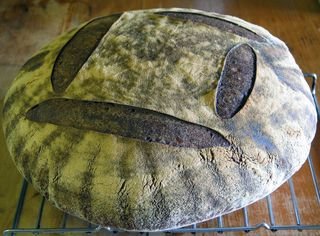
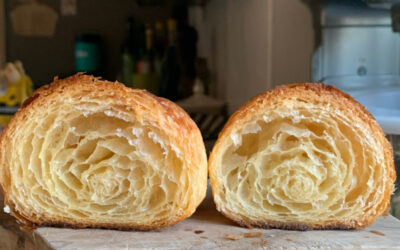
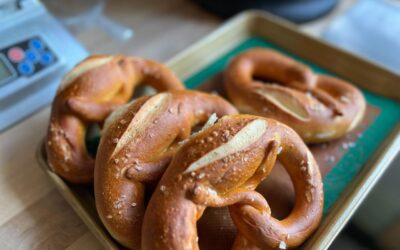
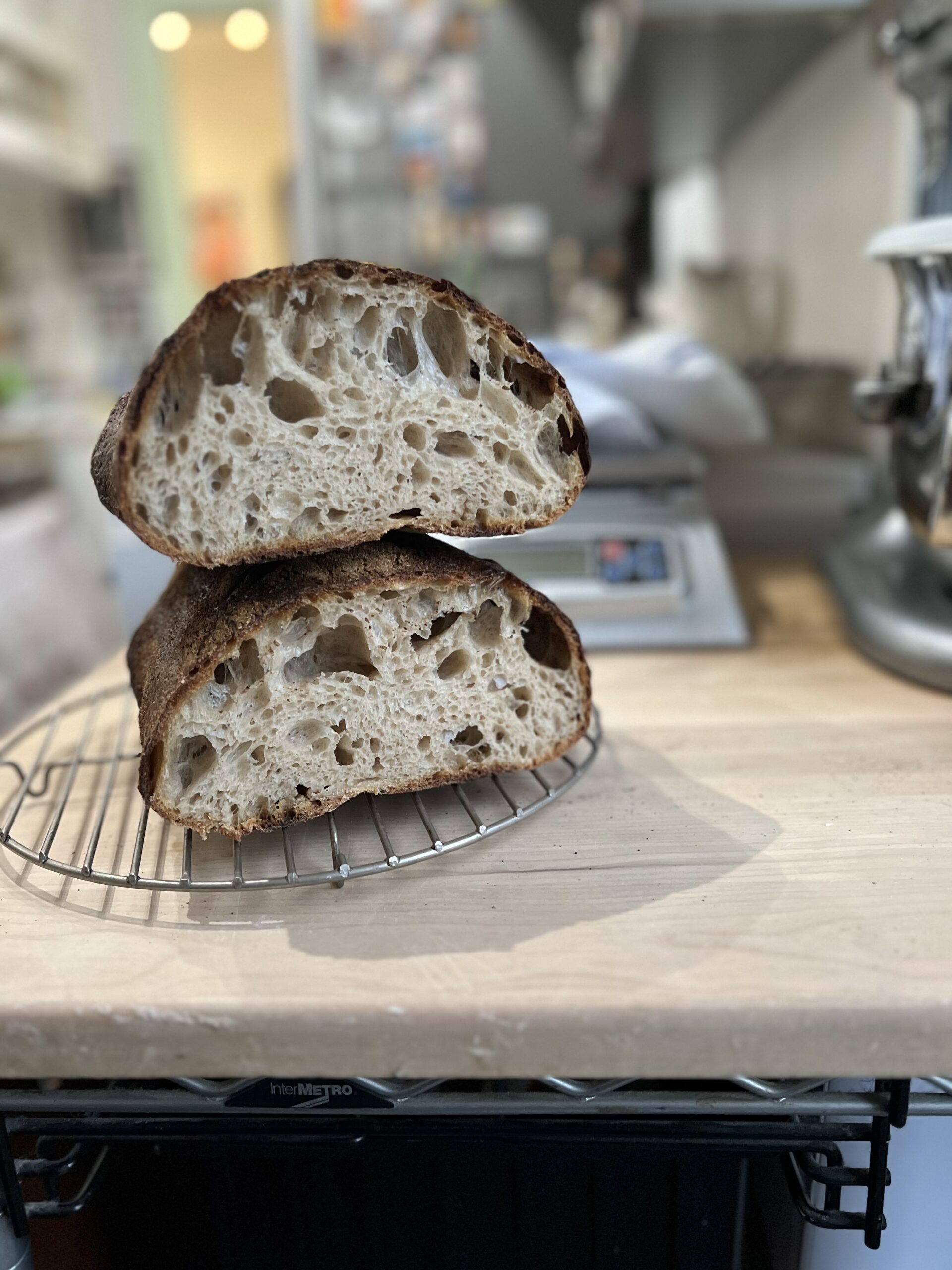
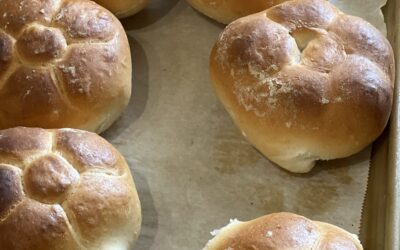
Funny, I just started the first levain build for a miche right before I came to the computer and saw this. One of my very favorite breads to make and eat. When I was in Paris last year I visited the Poilane shop. I was pleasantly surprised by how unassuming it was, not what I expected for such an internationally-recognized outfit. Unfortunately I was too shy and my French too limited to request a look downstairs.
Needless to say your Miche will be awesome!
Thanks for all these well-tested formulas. Will definitely make for interesting variations whether or not they’re the real deal.